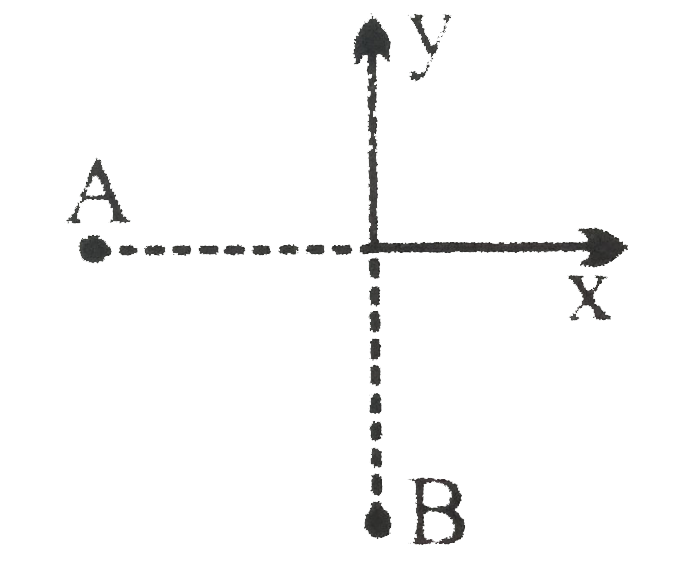Two linear simple harmonic motions of equal amplitude and frequency are impressed on a particle along x and y axis respectively. The initial phase difference between them is π2. The resultant path followed by the particle is
a circle
a straight line
an ellipse
a parabola
The correct Answer is:A
To solve the problem, we need to analyze the two linear simple harmonic motions (SHM) acting on a particle along the x and y axes, given that they have equal amplitude and frequency and an initial phase difference of π2.
1. Define the SHM along x-axis:
The motion along the x-axis can be described by the equation:
x=Asin(ωt)
where A is the amplitude, and ω is the angular frequency.
2. Define the SHM along y-axis:
The motion along the y-axis, with a phase difference of π2, can be described by:
y=Asin(ωt+π2)
Using the trigonometric identity sin(θ+π2)=cos(θ), we can rewrite this as:
y=Acos(ωt)
3. Relate the two equations:
We now have two equations:
x=Asin(ωt)
y=Acos(ωt)
4. Express sin(ωt) and cos(ωt):
From the first equation, we can express sin(ωt) as:
sin(ωt)=xA
And from the second equation, we can express cos(ωt) as:
cos(ωt)=yA
5. Use the Pythagorean identity:
We know from trigonometry that:
sin2(θ)+cos2(θ)=1
Applying this to our expressions gives:
(xA)2+(yA)2=1
Multiplying through by A2 results in:
x2+y2=A2
6. Identify the resultant path:
The equation x2+y2=A2 represents a circle with radius A. Therefore, the resultant path followed by the particle is a circle.
Final Answer:
The resultant path followed by the particle is a circle.
The motion along the x-axis can be described by the equation:
x=Asin(ωt)
where A is the amplitude, and ω is the angular frequency.
The motion along the y-axis, with a phase difference of π2, can be described by:
y=Asin(ωt+π2)
Using the trigonometric identity sin(θ+π2)=cos(θ), we can rewrite this as:
y=Acos(ωt)
We now have two equations:
x=Asin(ωt)
y=Acos(ωt)
From the first equation, we can express sin(ωt) as:
sin(ωt)=xA
And from the second equation, we can express cos(ωt) as:
cos(ωt)=yA
We know from trigonometry that:
sin2(θ)+cos2(θ)=1
Applying this to our expressions gives:
(xA)2+(yA)2=1
Multiplying through by A2 results in:
x2+y2=A2
The equation x2+y2=A2 represents a circle with radius A. Therefore, the resultant path followed by the particle is a circle.
The resultant path followed by the particle is a circle.
Topper's Solved these Questions
- SIMPLE HARMONIC MOTIONBOOK - DC PANDEY ENGLISHCHAPTER - SIMPLE HARMONIC MOTIONEXERCISE - JEE Advanced
34 Videos
- SIMPLE HARMONIC MOTIONBOOK - DC PANDEY ENGLISHCHAPTER - SIMPLE HARMONIC MOTIONEXERCISE - More than one option is correct
50 Videos
- SIMPLE HARMONIC MOTIONBOOK - DC PANDEY ENGLISHCHAPTER - SIMPLE HARMONIC MOTIONEXERCISE - Exercise 14.4
4 Videos
- SEMICONDUCTORS AND ELECTRONIC DEVICESBOOK - DC PANDEY ENGLISHCHAPTER - SEMICONDUCTORS AND ELECTRONIC DEVICESEXERCISE - More than One Option is Correct
3 Videos
- SOLVD PAPERS 2017 NEET, AIIMS & JIPMERBOOK - DC PANDEY ENGLISHCHAPTER - SOLVD PAPERS 2017 NEET, AIIMS & JIPMEREXERCISE - Solved paper 2018(JIPMER)
38 Videos
Similar Questions
Two linear SHM of equal amplitudes A and frequencies ω and 2ω are impressed on a particle along x and y−axes respectively. If the initial phase difference between them is π/2. Find the resultant path followed by the particle.
View SolutionTwo simple harmonic motions with the same frequency act on a particle at right angles i.e., along X-axis and Y-axis. If the two amplitudes are equal and the phase difference is π/2, the resultant motion will be
View Solution
Knowledge Check
Two particles execute SHMs of the same amplitude and frequency along the same straight line. They cross one another when going in opposite direction. What is the phase difference between them when their displacements are half of their amplitudes ?
A60∘B30∘C120∘D150∘
Particles A and B are moving with constant velocities along x and y axis respectively, the graph of separation between them with time is

View SolutionFind the equation fo simple harmonic motion of a particle whose amplitude is 0.04 and whose frequency is 50 Hz . The initial phase is π/3.
View SolutionWhen two mutually perpendicular simple harmonic motions of same frequency, amplitude and phase are superimposed.
View SolutionTwo particles execute simple harmonic motion of the same amplitude and frequency along close parallel lines. They pass each other moving in opposite directions each time their displacement is half their amplitude. Their phase difference is
View SolutionA particle is subjected to two simple harmonic motion in the same direction having equal amplitudes and equal frequency. If the resultant amplitude is equal to the amplitude of the individual motions. Find the phase difference between the individual motions.
View SolutionThree simple harmonic motions of equal amplitudes A and equal time periods in the same direction combine. The phase of the second motion is 60∘ ahead of the first and the phase of the third motion is 60∘ ahead of the second. Find the amplitude of the resultant motion.
View SolutionTwo simple harmonic motions y1=Asinωt and y2 = Acosωt are superimposed on a particle of mass m. The total mechanical energy of the particle is
View Solution
